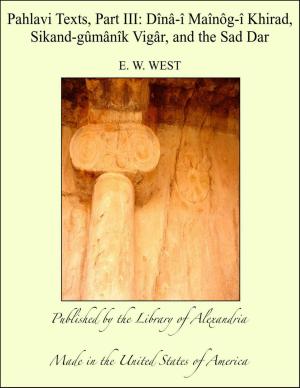| Author: | Wynfrid Laurence Henry Duckworth | ISBN: | 9781465599667 |
| Publisher: | Library of Alexandria | Publication: | March 8, 2015 |
| Imprint: | Language: | English |
| Author: | Wynfrid Laurence Henry Duckworth |
| ISBN: | 9781465599667 |
| Publisher: | Library of Alexandria |
| Publication: | March 8, 2015 |
| Imprint: | |
| Language: | English |
This book deals with the earliest phases in the past history of Mankind: the selected period ends at the Aurignacian division of the Palaeolithic Age. I regret to be unable to affix definite dates in years to the several divisions of time now recognised. To illustrate the difficulty of forming conclusions on this subject, it should be noted that in 1904 Professor Rutot assigned a duration of 139,000 years to the Pleistocene period, while in 1909 Dr Sturge claimed 700,000 years for a portion only of the same period. Evidently the present tendency is to increase enormously the drafts on geological time, and to measure in millions the years that have elapsed since the first traces of human existence were deposited. But in the face of estimates which differ so widely, it seemed preferable to distinguish subdivisions of time by reference to animal-types or the forms of stone-implements, rather than by the lapse of years. In the attempt to summarise a considerable amount of evidence, I have tried to select the facts most relevant to the subject in hand. And where an opinion is expressed I have endeavoured to indicate the reasons for the decision that is adopted. Additional evidence is pouring in at the present time, and there is no doubt but that the next few years will witness great extensions of knowledge. In this connection, I take the opportunity of mentioning the discovery made a few weeks ago by M. Henri Martin at La Quina, of a human skeleton resembling the Neanderthal type but presenting (it is said) definite features of inferiority to that type. another subject of vast importance is Mr Moir's recent demonstration of elaborately worked implements resting beneath strata referred to the Pliocene period.
This book deals with the earliest phases in the past history of Mankind: the selected period ends at the Aurignacian division of the Palaeolithic Age. I regret to be unable to affix definite dates in years to the several divisions of time now recognised. To illustrate the difficulty of forming conclusions on this subject, it should be noted that in 1904 Professor Rutot assigned a duration of 139,000 years to the Pleistocene period, while in 1909 Dr Sturge claimed 700,000 years for a portion only of the same period. Evidently the present tendency is to increase enormously the drafts on geological time, and to measure in millions the years that have elapsed since the first traces of human existence were deposited. But in the face of estimates which differ so widely, it seemed preferable to distinguish subdivisions of time by reference to animal-types or the forms of stone-implements, rather than by the lapse of years. In the attempt to summarise a considerable amount of evidence, I have tried to select the facts most relevant to the subject in hand. And where an opinion is expressed I have endeavoured to indicate the reasons for the decision that is adopted. Additional evidence is pouring in at the present time, and there is no doubt but that the next few years will witness great extensions of knowledge. In this connection, I take the opportunity of mentioning the discovery made a few weeks ago by M. Henri Martin at La Quina, of a human skeleton resembling the Neanderthal type but presenting (it is said) definite features of inferiority to that type. another subject of vast importance is Mr Moir's recent demonstration of elaborately worked implements resting beneath strata referred to the Pliocene period.















